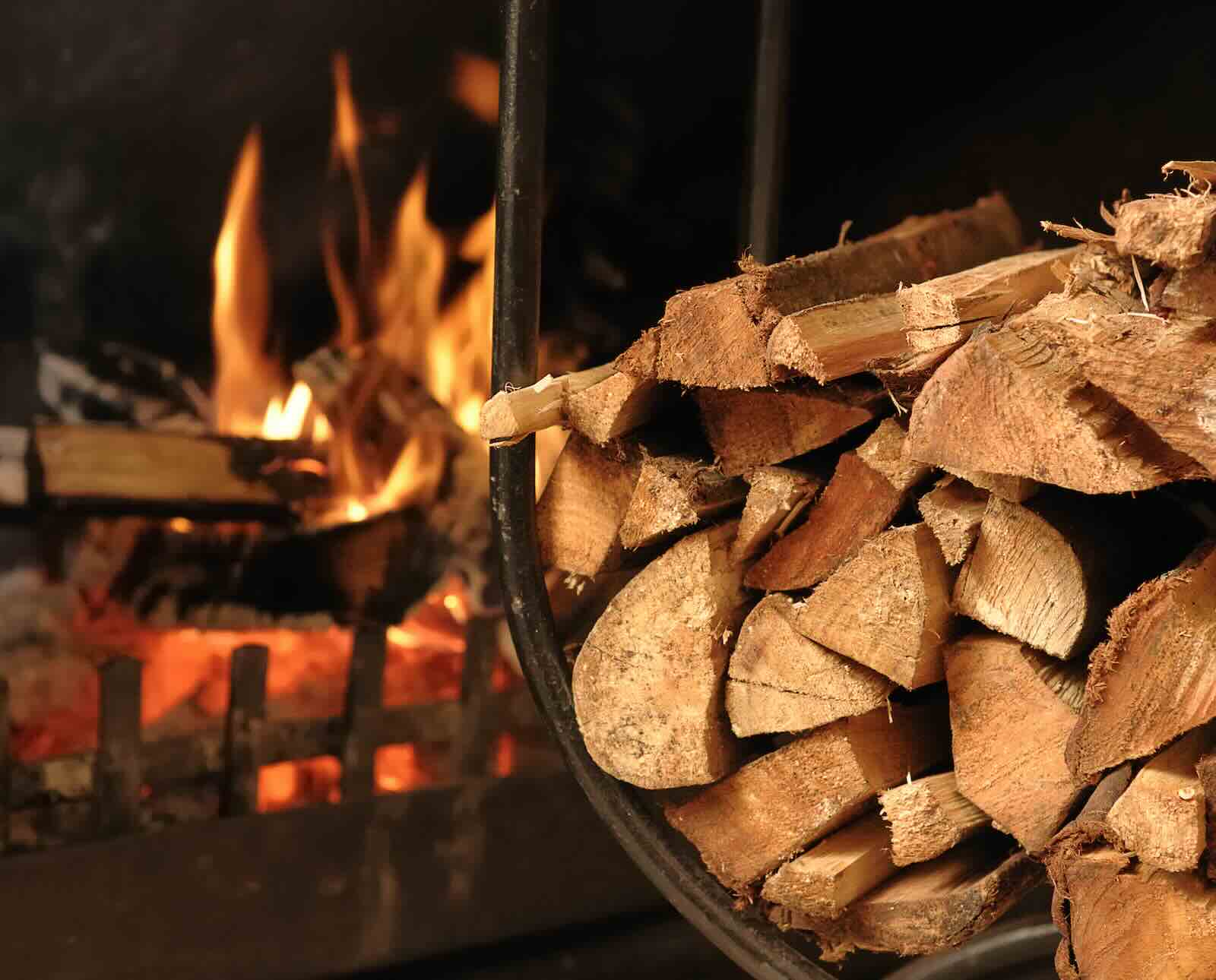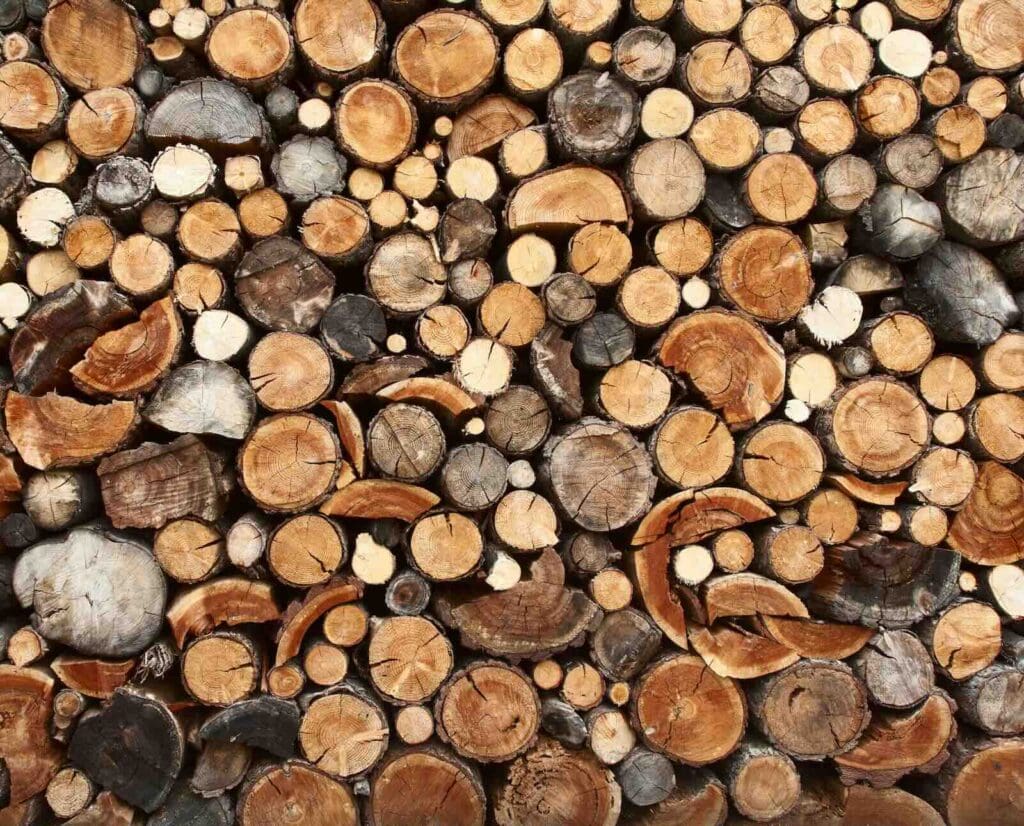Home » Foraging » How To Collect Your Own Firewood
How To Collect Your Own Firewood

Mark Parman lives in Seeley, Wisconsin, with his wife, Susan,…
Best practices for cutting, hauling, splitting, and storing firewood
Like Henry David Thoreau, I look at my full woodshed “with a kind of affection.” There’s something immensely satisfying knowing there’s enough firewood to keep the house warm through the long Wisconsin winter. The three or so cords of dry oak, maple, and birch is true wealth.
For thousands of years, gathering firewood was one of our most critical tasks. In this age of central heat that can be dialed with the flick of a wrist, we’ve mostly forgotten that our survival depended upon completing this job. Even so, in this age of fossil fuels, some people continue to forage for firewood so they can build fires and gather around the warm and lively heat.
Finding The Right Kind of Firewood
If you want to burn fires regularly – to heat your home, to fire up a sauna, or to bake wood-fired bread or pizza – you can either buy firewood or forage for it. If you plan on sourcing your own wood, first, you need to find a swath of woods with the right kind of trees.
Some people are lucky enough to own a woodlot of several acres. Access to woods like this can supply their annual firewood needs. An acre of well-managed, mature eastern hardwoods can sustainably provide a cord of wood (a 4’x4’x8’ stacked rectangular pile) per year. Immature trees or softer woods necessitate more acreage.
Once people hear that you burn wood, some of them might offer you free firewood. When we started heating with wood 30 years ago, friends and acquaintances asked if I’d remove fallen trees or even fell a tree on their property, which I would only do if absolutely certain I wouldn’t drop it on anything valuable. Most of these people wanted to get rid of their nuisance tree(s) – whether it was valuable as firewood or not – or just do me a favor.
I cut up a red pine for a friend once, but since this wood is full of pitch and produces creosote when burned (which can cause chimney fires), I only burned this wood in our outside fire pit. Another time – and only one time – I cut up a downed elm for one of my wife’s co-workers. I quickly learned that elm was stringy and nearly impossible to split by hand. It’s also a softwood and didn’t produce much heat, but I burned every damn stick I split.
If you live close to forested public land, consider buying a firewood permit from your county, state, or national forestry department. Every late winter or early spring, I buy a $10 cutting permit from the Sawyer County Forest Department, which entitles me to cut downed wood on two parcels of my choice. These numbered parcels are from recently logged select cuts on county land. The loggers typically haul away only the straight eight-foot hardwood bolts and leave behind the tree tops and anything twisted. In northern Wisconsin, loggers leave behind red oak, sugar maple, ash, white and yellow birch, and occasionally a bit of ironwood, sometimes in astonishing quantities.
Hauling Firewood
In order to gather enough wood to last the winter, you need some basic tools. First, you need a way to haul out the wood. We recently lost a mature sugar maple in a thunderstorm about 100 yards from our house. I debated snaking my truck through the woods down a skinny trail to the tree, but in the end, I wheelbarrowed the windfall home. With snow on the ground, I would have skidded up to my shed in my ice fishing sled. This method of hauling required multiple trips, but I figured I would prefer to work harder than dent up my truck.
Hauling wood for more than a hundred yards requires a truck or a trailer – although I have a friend who heaves his firewood into the back of an old Honda Element. At some point, gathering firewood with a vehicle and trailer gets inefficient. The time and resources you use to obtain firewood surpass the BTUs it’ll create. For example, I don’t like to travel more than 20 miles or so to gather firewood.
Chainsaws and Hand Tools
I’ve read about people who cut and split their firewood entirely by hand, which is how pretty much everyone did it a century ago. Although chainsaws are noisy, stinky, and dangerous (at least as dangerous as a loaded shotgun), I can’t imagine hand-cutting all the wood to fill my woodshed. I don’t have the strength, patience, or time to cut up a 20-inch oak by hand. My dad used to tell nostalgic stories about when he was a kid on the farm and used a crosscut saw and horses to keep his large family warm through a Wisconsin winter. However, he didn’t hesitate to buy a chainsaw when they became readily available later in his life.
Buying and learning to use a chainsaw safely is an article in itself. Electric chainsaws have become increasingly popular, especially since they started using batteries instead of cords for power. If you plan on cutting a lot of wood, as in several cords per year, a gas-powered saw is preferable. I use less than two gallons of gas and two-stroke oil per year to make all of my wood.
Chainsaws are inherently dangerous. The chain can travel as much as 70 miles per hour around the bar. If this doesn’t scare you, it should. If you have never operated a chainsaw, I would suggest finding a mentor or taking a class to learn how to correctly use one. With a chainsaw, you can harm yourself two ways – sawing into your body and dropping a limb or a trunk on yourself. One of the safer things about cutting on public land is that you cannot cut standing timber and must cut downed wood, which greatly lessens the chance of dropping a tree on you or a friendly helper. Felling a tree is usually a much more difficult and fraught task than cutting up a tree on the ground.
You need a few additional accessories for operating a chainsaw, including files to keep the chain sharp, which is an absolute must for efficient cutting. I hand-file mine after every three or four tanks of gas. I also own three or four chains for both of my saws and get them professionally sharpened on rotation. You need hearing protection, eye protection, and chaps, too.
I also own several hand tools, such as my Gransfors splitting maul, which I use even more often than my chainsaw. This quickest and easiest way to split wood is with a hydraulic splitter, but these are expensive, even when bought second-hand. Occasionally, I use a limbing axe and have a box full of wedges – some for splitting, some for felling. Sometimes, I use a peavey to move or lift heavy logs off the ground. A peavey is basically a long lever with a hook attached at its end. These items can add up quickly and make plain that even wood heat is not free. It never has been, unless your labor is worthless.

Drying and Storing Firewood
Once your wood is cut and split, it needs to dry out in some sort of stack or woodshed. After I haul my cut rounds home, I dump them next to my main woodshed, where they get split and stacked. Some people like to split their firewood at the collection site because of all of the “mess” it makes in the form of wood chips and bark. Since I make hundreds of fires per year, I split at home. I like to have the chips and bark around to use as kindling.
My small woodshed has a footprint of about 3’x5’. I fill it with short pieces of firewood less than a foot long. These go in a second, much smaller woodstove that heats a room above our garage. Our main stove in the house takes firewood up to 24” long, and these pieces are easy to stack.
You don’t necessarily need a dedicated woodshed to dry and store firewood. When ours is full and I have extra wood, I make a stack or two on pallets next to the woodshed. I call these piles with woven corners my Holzhausen (German for wood houses). You can also stack them in a round shape like a beaver lodge. In rural Norway, there are contests for the most artistic wood stack sculptures. Lars Mytting’s book, Norwegian Wood, shows a picture of wood stacked into what looks like a lake trout. Another looks like a small barn with a Dutch gambrel roof.
My stacks are not artistic, but they are efficient and easy to make. Basically, I form squares with woven ends and a peaked roof. If I have white birch while making stacks, I save it for the roof. The bark effectively sheds water and makes the pile nearly watertight. One of my neighbors uses wood cribs out of hog fence and pallets because he had to cut his wood in short sticks (about 12”) to fit in his stove. Since short wood is difficult to stack, he chucks it into the crib, which can be handily moved with his skid steer.
One of the most popular ways to stack and dry firewood around here is simply to stack it between two trees. Lay down two parallel tree limbs or old deck boards between the trees to keep the bottom row of firewood off the ground and as dry as possible. Cover the stack, which now looks like a wood wall or fence, with old metal roofing, OSB or plywood, canvas tarping, or any other material that will shed water.
Over the years, I’m sure we’ve saved thousands of dollars by heating our home with wood. However, if I included all of my time and labor processing wood, I might have to reconsider the financial advantage. Burning wood does cut our dependence on fossil fuels as well as energy transported in from who-knows-where. These are all reasons I burn wood, but more than anything, I just like having a lively fire humming in the wood stove, making the house warm and bright. There’s nothing like a good fire.
Mark Parman lives in Seeley, Wisconsin, with his wife, Susan, and setters, Fergus and Jenkins. He has written two books about ruffed grouse hunting: Among the Aspen and A Grouse Hunter's Almanac. He still enjoys a good paper map.



